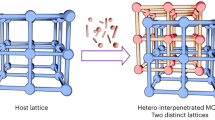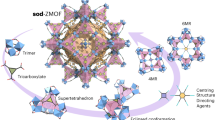Abstract
The convergent assembly of metal–organic frameworks has enabled the design of porous materials using a structural building unit approach, but functional systems incorporating pre-assembled structural building unit ‘pore’ openings are rare. Here, we show that the face-directed assembly of a ring-shaped macrocyclic polyoxometalate structural building unit, {P8W48O184}40− with an integrated 1-nm pore as an ‘aperture synthon’, with manganese linkers yields a vast three-dimensional extended framework architecture based on a truncated cuboctahedron. The 1-nm-diameter entrance pores of the {P8W48O184}40− structural building unit lead to approximately spherical 7.24-nm3 cavities containing exchangeable alkali-metal cations that can be replaced by transition-metal ions through a cation exchange process. Control over this process can be exerted by either electrochemically switching the overall framework charge by manipulating the oxidation state of the manganese linker ions, or by physically gating the pores with large organic cations, thus demonstrating how metal–organic framework-like structures with integrated pores and new physical properties can be assembled.
This is a preview of subscription content, access via your institution
Access options
Subscribe to this journal
Receive 12 print issues and online access
$259.00 per year
only $21.58 per issue
Buy this article
- Purchase on Springer Link
- Instant access to full article PDF
Prices may be subject to local taxes which are calculated during checkout



Similar content being viewed by others
References
Takeda, N., Umemoto, K., Tamaguchi, K. & Fujita, M. A nanometre-sized hexahedral coordination capsule assembled from 24 components. Nature 398, 794–796 (1999).
Pluth, M. D., Bergman, R. G. & Raymond, K. N. Acid catalysis in basic solution: a supramolecular host promotes orthoformate hydrolysis. Science 316, 85–88 (2007).
Ziv, A. et al. Flexible pores of a metal oxide-based capsule permit entry of comparatively larger organic guests. J. Am. Chem. Soc. 131, 6380–6382 (2009).
Mal, P., Breiner, B., Rissanen, K. & Nitschke, J. R. White phosphorus is air-stable within a self-assembled tetrahedral capsule. Science 324, 1697–1699 (2009).
Dinolfo, P. H. & Hupp, J. T. Supramolecular coordination chemistry and functional microporous molecular materials. Chem. Mater. 13, 3113–3125 (2001).
Sato, S. et al. Fluorous nanodroplets structurally confined in an organopalladium sphere. Science 313, 1273–1276 (2006).
Yaghi, O. M. et al. Reticular synthesis and the design of new materials. Nature 423, 705–714 (2003).
Olenyuk, B., Whiteford, J. A., Fechtenkötter, A. & Stang, P. J. Self-assembly of nanoscale cuboctahedra by coordination chemistry. Nature 398, 796–799 (1999).
Li, Q. et al. Docking in metal-organic frameworks. Science 325, 855–859 (2009).
Rowsell, J. & Yaghi, O. M. Metal–organic frameworks: a new class of porous materials. Microporous Mesoporous Mater. 73, 3–14 (2004).
Perry, J. J., Perman, P. A. & Zaworotko, M. J. Design and synthesis of metal–organic frameworks using metal–organic polyhedra as supermolecular building blocks. Chem. Soc. Rev. 38, 1400–1417 (2009).
Kitagawa, S., Kitaura, R. & Noro, S.-I. Functional porous coordination polymers. Angew. Chem. Int. Ed. 43, 2334–2375 (2004).
Tao, Y., Kanoh, H., Abrams, L. & Kaneko, K. Mesopore-modified zeolites: preparation, characterization and applications. Chem. Rev. 106, 896–910 (2006).
Long, D.-L., Burkholder, E. & Cronin, L. Polyoxometalate clusters, nanostructures and materials: from self assembly to designer materials and devices. Chem. Soc. Rev. 36, 105–121 (2007).
Müller, A. et al. Artificial cells: temperature-dependent, reversible Li+-ion uptake/release equilibrium at metal oxide nanocontainer pores. Angew. Chem. Int. Ed. 43, 4466–4470 (2004).
Geletii, Y. V. et al. An all-inorganic, stable and highly active tetraruthenium homogeneous catalyst for water oxidation. Angew. Chem. Int. Ed. 47, 3896–3899 (2008).
Dolbecq, A. et al. Hybrid 2D and 3D frameworks based on ε-Keggin polyoxometalates: experimental and simulation. Eur. J. Inorg. Chem. 3009–3018 (2005).
Rodriguez-Albelo, L. M. et al. Zeolitic polyoxometalate-based metal–organic frameworks (Z-POMOFs): computational evaluation of hypothetical polymorphs and the successful targeted synthesis of the redox-active Z-POMOF1. J. Am. Chem. Soc. 131, 16078–16087 (2009).
Müller, A., Shah, S. Q. N., Bögge, H. & Schmidtmann, M. Molecular growth from a Mo176 to a Mo248 cluster. Nature 397, 47–50 (1999).
Schemberg, J. et al. Towards biological supramolecular chemistry: a variety of pocket-templated, individual metal oxide cluster nucleations in the cavity of a Mo/W-storage protein. Angew. Chem. Int. Ed. 46, 2408–2413 (2007).
AlDamen, M. A. et al. Mononuclear lanthanide single-molecule magnets based on polyoxometalates. J. Am. Chem. Soc. 130, 8874–8875 (2008).
Pope, M. T. & Müller, A. Polyoxometalate Chemistry: From Topology via Self-Assembly to Applications (Kluwer, 2001).
Pradeep, C. P., Long, D.-L., Kögerler, P & Cronin, L. Controlled assembly and solution observation of a 2.6 nm polyoxometalate ‘super’ tetrahedron cluster: [KFe12(OH)18(α-1,2,3-P2W15O56)4]29−. Chem. Commun. 4254–4256 (2007).
Ritchie, C. et al. Reversible redox reactions in an extended polyoxometalate framework solid. Angew. Chem. Int. Ed. 47, 6881–6884 (2008).
Uchida, S., Hashimoto, M. & Mizuno, N. A breathing ionic crystal displaying selective binding of small alcohols and nitriles: K3[Cr3O(OOCH)6(H2O)3][α-SiW12O40]·16H2O. Angew. Chem. Int. Ed. 42, 2814–2817 (2002).
Van Bekkum, H., Flanigen, E. M., Jacobs, P. A. & Jansen, J. C. (eds) Introduction to Zeolite Science and Practice (Elsevier, 2001).
van Bekkum, H. & Cejka, J. Zeolites and ordered mesoporous materials: progress and prospects, in Studies in Surface Science Vol. 157 (Elsevier, 2005).
Contant, R. & Teze, A. A new crown heteropolyanion, K28Li5H7P8W48O184·92H2O: synthesis, structure and properties. Inorg. Chem. 24, 4610–4614 (1985).
Müller, A. et al. Metal-oxide-based nucleation process under confined conditions: two mixed-valence V6-type aggregates closing the W48 wheel-type cluster cavities. Angew Chem. Int. Ed. 46, 4477–4480 (2007).
Mal, S. & Kortz, U. The wheel-shaped Cu20-tungstophosphate [Cu20Cl(OH)24(H2O)12(P8W48O184)]25− ion. Angew. Chem. Int. Ed. 44, 3777–3870 (2005).
Sheldrick, G. M. Phase annealing in SHELX-90: direct methods for larger structures. Acta Crystallogr. A 46, 467–473 (1990).
Sheldrick, G. M. A short history of SHELX. Acta Cryst. A 64, 112–122 (2008).
Farrugia, L. J. WinGX suite for small-molecule single-crystal crystallography. J. Appl. Cryst. 32, 837–838 (1999).
Clark, R. C. & Reid, J. S. The analytical calculation of absorption in multifaceted crystals. Acta Cryst. A 51, 887–897 (1995).
Acknowledgements
This work was supported by the EPSRC, BP Chemicals, WestCHEM, The Leverhulme Trust and The University of Glasgow. The authors would like to thank M. Beglan for assistance with FP and FAAS analysis and A. Macdonell for the concept movie showing the assembly of the cubic array.
Author information
Authors and Affiliations
Contributions
S.M. and L.C. designed experiments, analysed data, prepared the figures and wrote the manuscript. C.S. provided invaluable advice and assisted with the PXRD. H.M. performed electrochemistry measurements. D.L. checked the crystallography. T.B. verified the synthesis.
Corresponding author
Ethics declarations
Competing interests
The authors declare no competing financial interests.
Supplementary information
Supplementary information
Supplementary information (PDF 2365 kb)
Rights and permissions
About this article
Cite this article
Mitchell, S., Streb, C., Miras, H. et al. Face-directed self-assembly of an electronically active Archimedean polyoxometalate architecture. Nature Chem 2, 308–312 (2010). https://doi.org/10.1038/nchem.581
Received:
Accepted:
Published:
Issue Date:
DOI: https://doi.org/10.1038/nchem.581
This article is cited by
-
Surface-exposed silver nanoclusters inside molecular metal oxide cavities
Nature Chemistry (2023)
-
Polyoxometalate Clusters: Inorganic Ligands for Functional Materials
Journal of Cluster Science (2022)
-
Covalent hybrid materials between polyoxometalates and organic molecules for enhanced electrochemical properties
Journal of Materials Science (2020)
-
Synergistic Effect of POMCPs and PPy for Enhancing Visible-Light Photocatalytic Activity and High Quantum Yields
Journal of Cluster Science (2019)
-
A zeolitic vanadotungstate family with structural diversity and ultrahigh porosity for catalysis
Nature Communications (2018)



